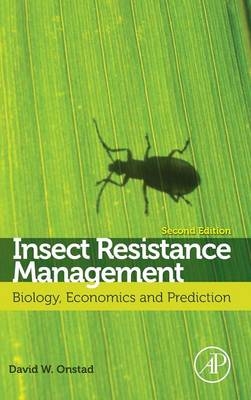
Insect Resistance Management
Academic Press Inc (Verlag)
978-0-12-396955-2 (ISBN)
- Titel erscheint in neuer Auflage
- Artikel merken
Neither pest management nor resistance management can occur with only an understanding of pest biology. For years, entomologists have understood, with their use of economic thresholds, that at least a minimal use of economics was necessary for proper integrated pest management. IRM is even more complicated and dependent on understanding and using socioeconomic factors. The new edition of Insect Resistance Management addresses these issues and much more.
Many new ideas, facts and case studies have been developed since the previous edition of Insect Resistance Management published. With a new chapter focusing on Resistance Mechanisms Related to Plant-incorporated Toxins and heavily expanded revisions of several existing chapters, this new volume will be an invaluable resource for IRM researchers, practitioners, professors and advanced students. Authors in this edition include professors at major universities, leaders in the chemical and seed industry, evolutionary biologists and active IRM practitioners. This revision also contains more information about IRM outside North America, and a modeling chapter contains a large new section on uncertainty analysis, a subject recently emphasized by the U.S. Environmental Protection Agency. The final chapter contains a section on insecticidal seed treatments.
No other book has the breadth of coverage of Insect Resistance Management, 2e. It not only covers molecular to economic issues, but also transgenic crops, seed treatments and other pest management tactics such as crop rotation. Major themes continuing from the first edition include the importance of using IRM in the integrated pest management paradigm, the need to study and account for pest behavior, and the influence of human behavior and decision making in IRM.
Dr. David W. Onstad has been an entomologist for over 40 years focusing on insect resistance management, insect epizootiology, economics of integrated pest management, and ecological modeling. He was elected fellow of the Entomological Society of America in 2022. Since retiring after 26 years as a professor at the University of Illinois, he has been the lead mathematical modeler for DuPont Pioneer/CortevaAgriscience in support of data-driven strategic decision-making, assessing resistance risks, and product registration and development of transgenic insecticidal crops.
1. Major Issues in Insect Resistance Management
2. Valuing Pest Susceptibility to Control
3. Understanding Resistance and Induced Responses of Insects to Xenobiotics and Insecticides in the Age of "Omics" and Systems Biology
4. Resistance Mechanisms Related to Plant-incorporated Toxins
5. Concepts and Complexities of Population Genetics
6. Resistance by Ectoparasites
7. Insect Resistance to Crop Rotation
8. Arthropod Resistance to Crops
9. The Role of Landscapes in Insect Resistance Management
10. Negative Cross-Resistance: History, Present Status, and Emerging Opportunities
11. The Roles of Natural Enemies and Density-Dependent Mortality in Resistance Management
12. Insect Resistance Management: Adoption and Compliance
13. Modeling for Prediction and Management
14. Monitoring Resistance
15. IPM and Insect Resistance Management
| Erscheint lt. Verlag | 23.10.2013 |
|---|---|
| Verlagsort | San Diego |
| Sprache | englisch |
| Maße | 152 x 229 mm |
| Gewicht | 940 g |
| Themenwelt | Naturwissenschaften ► Biologie ► Zoologie |
| Weitere Fachgebiete ► Land- / Forstwirtschaft / Fischerei | |
| ISBN-10 | 0-12-396955-7 / 0123969557 |
| ISBN-13 | 978-0-12-396955-2 / 9780123969552 |
| Zustand | Neuware |
| Haben Sie eine Frage zum Produkt? |
aus dem Bereich



